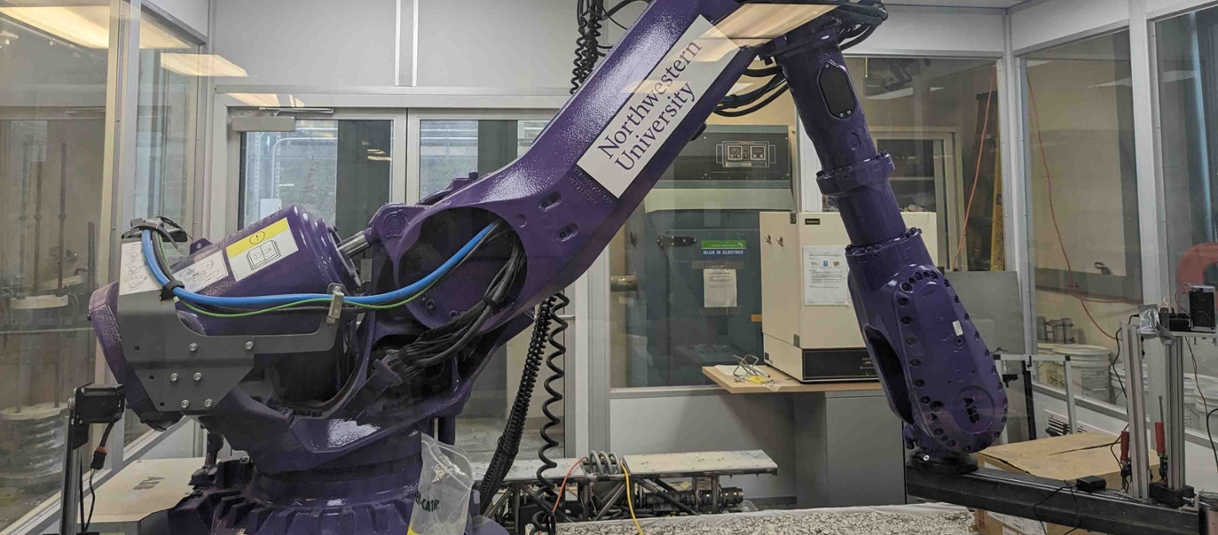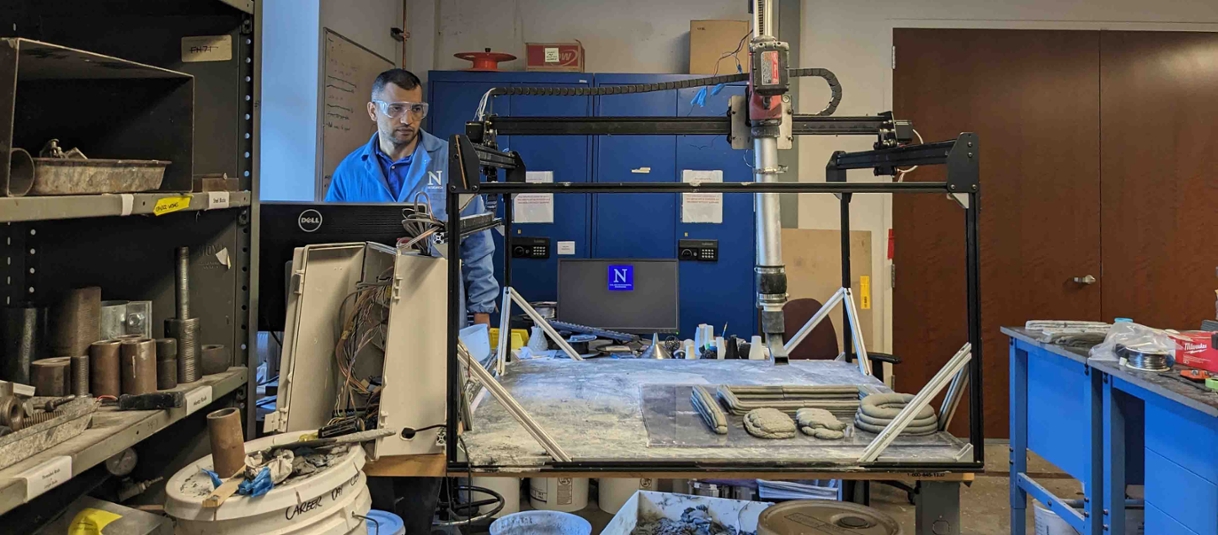Gianluca Cusatis and Research Team Explore the Possibilities of Printing Concrete
Professor Gianluca Cusatis and his research team are breaking new ground through the integration of ultra-high-performance concrete (UHPC) into large-scale 3D printing methods as they look to extend the reach of 3D printing applications.
The project, entitled, “Multi-Scale Additive Manufacturing of Ultra High-Performance Fiber Reinforced Concrete: Experiments and Computations,” is funded through the Engineer Research and Development Center (ERDC) from the Army Corps of Engineers. Cusatis and his lab received $1.5 million to study the effects of printing UHPC over three years.
 Cusatis said that his group was chosen because of Northwestern’s innovative facilities.
Cusatis said that his group was chosen because of Northwestern’s innovative facilities.
“Our facilities were instrumental in getting funding for our project because we had shown in our proposal that we had ways to study these materials – both experimentally and computationally,” he said. “Most of the work that has been done before has been experimental, which means you do trial and error and see what works best. We try to, instead, study the problem experimentally and computationally so we can reach an optimal solution faster and more successfully.”
This funding has allowed Cusatis and his fellows to conduct both small and large-scale printing with three varieties of printers in the laboratory.
These include a small-scale 3D plastic printer, mostly used for 3D printing of plastic nozzles, a medium-scale 3D Gantry printer, and a large-scale ABB robotic arm system. A fascinating addition to the facilities has been a one-dimensional printer, tailored for unidirectional movement.

The goal of the project is to further innovate the construction industry.
“While many industries have seen an increase of productivity in the last 60 years, the construction industry has seen a decline,” Cusatis said. “Some studies suggest that the lack of automation available is the reason for this decline since other industries have embraced automation.”
“But printing is one of the technologies that can automate the field,” he said. “You can optimize the shape of the structure, and structural elements are no longer limited to rectangular shapes – you can make curves, etc.”
Another way 3D printing optimizes the industry is through minimizing material use, Cusatis said.
“If you use less material, you can reduce the impact on the environment and potentially reduce the amount of CO2 emissions associated with construction,” he said. “Printing also allows for the reduction of the cost of the structure.”
Printing concrete, or the additive manufacturing of concrete, can improve the ways humans live on Earth and even beyond, said postdoctoral fellow Raúl Marrero Rosa.
“Additive manufacturing can bring a way to rapidly deploy houses for communities struck by hurricanes, fires, tsunamis, and earthquakes and try to make life better for the citizens affected by these natural disasters,” he said. “The knowledge we acquire on Earth can be taken beyond Earth to build structures in remote regions.”

So far, the team -- consisting of 5 Ph.D students, 5 postdoctoral fellows including Shady Gomaa and Raúl Marrero Rosa, and around a dozen external collaborators who divide the computational and experimental research -- have successfully employed nanomodification techniques on the fresh UHPC mixture, enhancing its rheological properties to enable printability. After a series of experiments, the team successfully utilized nano clay in the UHPC mix to make it printable.
With the first year over, the team has not only met but surpassed the year-one project milestones, which included printing with UHPC cement paste.
Now onto the second year of experimentation; Gomaa said that each year is expected to bring a new set of challenges as printing concrete around reinforcement is a complex issue that constantly needs to be readdressed.
“In the first year, our challenge centered around effectively incorporating nano-modification materials to achieve UHPC printability,” he said. “This accomplishment marks a significant milestone, especially as we approach the conclusion of the first year. Moving into the second year, our focus will shift to the complexities of printing with steel fibers and concurrently pumping the material. Finally, the third year will bring its obstacle: successfully printing UHPC with longitudinal reinforcement for large-scale complex structures.”
Marrero Rosa said he feels that the biggest challenge has been the synergetic effect between the printing process and material development.
“Depending on the system of printing or nozzle, the material can experience different shearing conditions, which for a non-Newtonian fluid like concrete, will change the behavior of flow,” he said. “This leads to gathering data with different amounts of nanomaterials. In this process, we collect as much data as possible from the experimental test. This can help our computational team narrow the mix design properties to the shear history for other printing systems. This will make the mix design optimization process faster, aiming for performance-based properties.”
While challenging, Marrero Rosa feels that the thought-provoking complexity of printing low-water content UHPC is the most exciting part.
“After the printing is ‘done,’ the curiosity kicks back and creates new questions, which keeps me studying the problem,” he said. “As an example: How does the geometrical form of the 3D printed specimen affect the mechanism of failure and crack patterns compared to the cast-in-place specimens? Now, stress concentrations between the layers can appear due to the geometrical shape of the printed sample. This will affect its behavior.”
Marrero Rosa’s involvement in the concrete printing process began as a Ph.D. candidate at Northwestern.
“During my time as a Ph.D. student, I had the opportunity to collaborate with Prof. Cusatis's group in the material development group for the NASA Challenge project to design and create a 3D printed habitat on Mars,” he said. “At this time, we studied two materials for printing: (1) Portland cement composite (concrete) and (2) Martian concrete (sulfur concrete). The NASA project led to my interest in additive manufacturing of construction materials and studying the development of testing procedures to characterize concrete mechanics in the fresh and hardened state.”
Gomaa said his passion for pushing the boundaries of 3D printing technology led him to join this project.
“My prior experience in studying the behavior of UHPC and concrete 3D printing motivated me to adapt to the challenges presented by this project,” he said. “Being part of the team has allowed me to explore new techniques enabling the printability of UHPC.”
In the future, 3D printing could be used to construct whole buildings, Cusatis said.
“Printing doesn’t have a field application, but it has an industrial indoor application,” he said. “Elements can be combined to create a structure, like how cars are assembled piece by piece. You could print the elements of a structure independently and then assemble them.”
For the last year of the project, the team hopes to collaborate with other institutions, including the Department of Energy.

